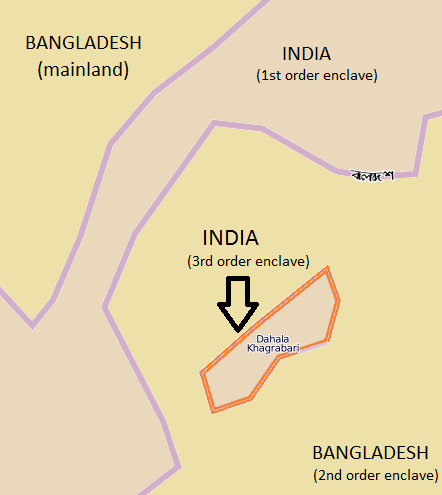After years of negotiation, recent reports suggest that India is close to resolving its border dispute with Bangladesh, now that the current Indian government supports a resolution. Territorial changes in India need to be approved via constitutional amendment which explains why it would be most difficult for India to make territorial swaps with China or Pakistan without the entire Indian establishment being on board. Previous attempts at exchanging territory with Bangladesh all ran into trouble because of whichever party was in opposition in the Indian Parliament at the time.
The present agreement is known as the Land Boundary Agreement(LBA) and was negotiated by former Prime Minister Manmohan Singh with Bangladesh in 2011. The currently ruling Bharatiya Janata Party (BJP) and Prime Minister Narendra Modi opposed the agreement at the time and thus the agreement did not go through. This is the same agreement that the BJP is now supporting. The reason given for this U-turn was given by Prime Minister Modi on Sunday in a speech given in Assam, which borders Bangladesh to the north. Modi declared that his government would in fact ratify the agreement in order to improve India’s security and curb illegal immigration from Bangladesh. With all major Indian parties now in favor of a border agreement with Bangladesh, an amendment to the Indian constitution is expected topass quickly and without much political difficulty.
Bangladesh’s border with India is an interesting and unique case of a dispute – one that cannot be compared with India’s border disputes with other countries. The nature of the Indo-Bangladeshi border makes a resolution involving a territorial swap all but necessary. Strewn along Bangladesh’s northern border with India are hundreds ofenclaves. There are 111 Indian enclaves in Bangladesh – Indian territory completely surrounded by Bangladesh, and 51 Bangladeshi enclaves in India. Some of these enclaves are second order enclaves. The result is an archipelago of enclaves along the Indo-Bangladeshi border.
The Indo-Bangladesh border is also home to the world’s only third order enclave, the Indian Dahala Khagrabari. To see just how crazy this is, understand that this means that it is a piece of India within Bangladesh, within India, within Bangladesh.

India’s strange boundary with Bangladesh came about because of pre-colonial politics during the Mughal Empire. While most of Bengal was a Mughal province, the state of Cooch Behar remained independent to its north. However, landowners from both Bengal and Cooch Behar ownedproperties and fiefs on both sides of the border, which resulted in the present situation. Sovereignty in this period in South Asia was not necessarily the result of straight territorial boundaries but a function of who paid taxes and was subordinate to whom. The current borders seem to be the “result of peace treaties in 1711 and 1713 between the kingdom of Cooch Behar and the Mughal Empire, ending a long series of wars in which the Mughals wrested several districts from Cooch Behar.” A popular legend stating that the enclaves are the result of local rulers wagering villages in games of chess is anecdotal. Later on Cooch Behar became a princely state under British protection while Bengal was a province in British India. When Bengal was partitioned in 1947, a part of it became part of India and a part East Pakistan (later Bangladesh), while the princely state of Cooch Behar joined India. As a result, parts of it were surrounded by non-Indian territory and parts of East Pakistan were in India as a result of Cooch Behar joining India.
When Bangladesh became independent in 1971, India and Bangladesh attempted to resolve the problem of their enclaves. A 1974 agreementsigned between then Indian Prime Minister Indira Gandhi and Bangladesh’s leader Sheikh Mujibur Rahman was not ratified in India. The present treaty is broadly similar to the original one. India will acquire 51 enclaves and 2,777 acres of land and transfer 111 enclaves and 2,267 acres to Bangladesh. There is no doubt that this deal will be strongly beneficial for both India and Bangladesh by finally resolving a long standing cause of tension between both countries. It is also in the interests of the people of the enclaves, as it will finally give them access to the services of India and Bangladesh.
Source: The Diplomat








